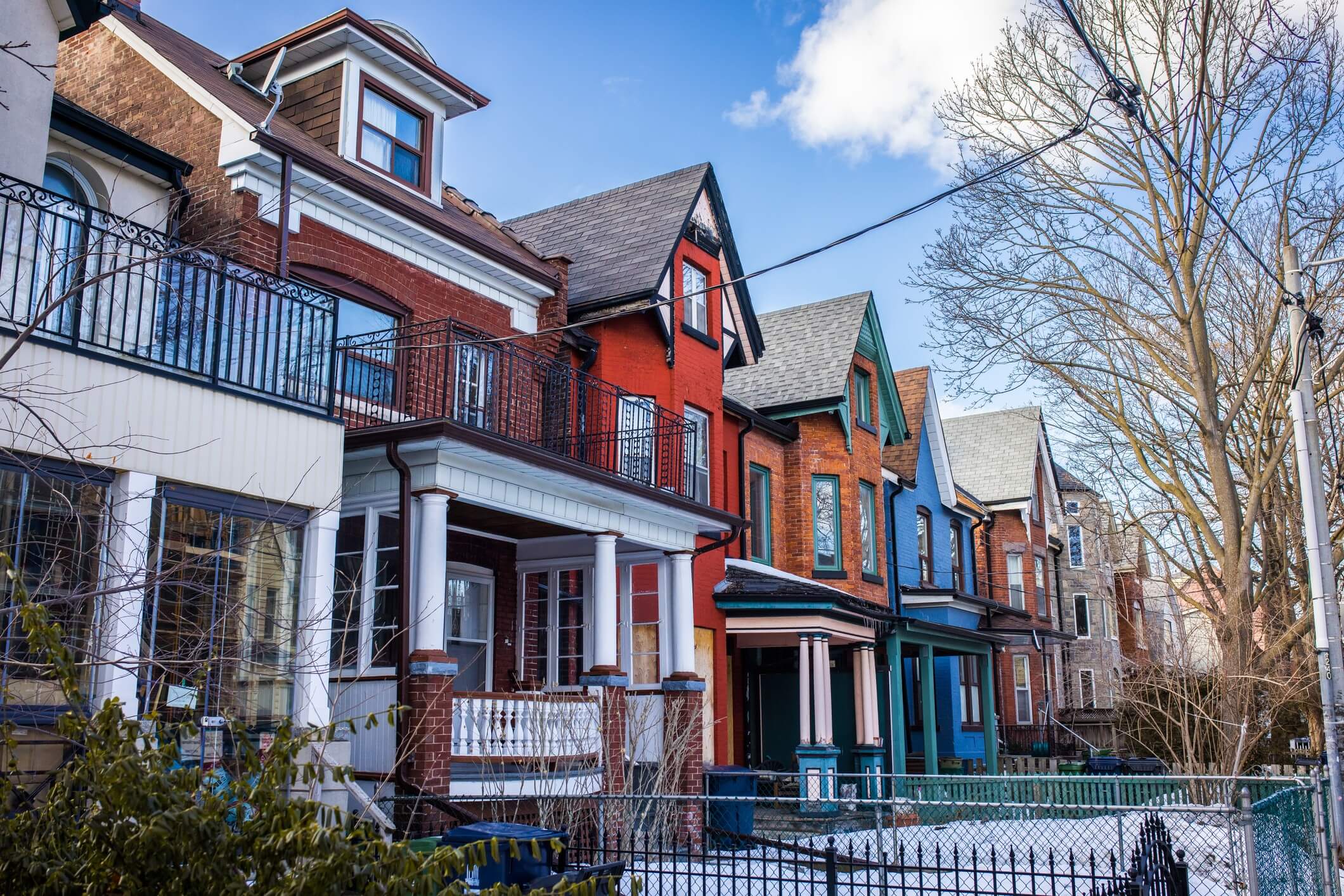
Toronto's older neighbourhoods are renowned for their distinctive architecture and historical significance, creating a unique urban tapestry that residents cherish. However, homeowners in these areas face significant challenges when updating their properties with modern amenities, particularly heating and cooling systems. The integration of new technologies into old structures must be handled with care to preserve the original aesthetic and structural integrity of these homes. Traditional HVAC systems, which often require extensive ductwork, can disrupt the historical elements that give these properties their unique character.
Ductless mini-split systems are a modern solution that offers efficient heating and cooling without the invasive installation process associated with traditional systems. Ductless mini-splits are comprised of a small outdoor unit and one or more indoor units that require nothing more than a small hole in the wall for installation.
This system is not only less intrusive but also offers a versatile and energy-efficient alternative that can be tailored to the specific needs of each room in the home.
What is a Ductless Mini-Split System?
A ductless mini-split system is an air conditioning and heating solution that operates without the extensive network of ducts required by traditional HVAC systems. This type of system is particularly well-suited for buildings where duct installation is impractical or too invasive.
Ductless mini-splits consist of two main components: an outdoor compressor/condenser and one or more indoor air-handling units. These components are connected by a conduit that houses the power cable, refrigerant tubing, and a condensate drain line, enabling a direct transfer of heat without the need for ductwork.
Key Components of a Ductless Mini-Split System
-
Outdoor Unit: The outdoor unit of a ductless mini-split system contains the compressor and condenser. It is typically installed on the ground outside the home or mounted on an exterior wall. This unit is responsible for expelling heat during the cooling cycle and drawing in heat during the heating cycle.
-
Indoor Air-Handling Units: Each indoor unit is installed in a separate room or zone and can be independently controlled. These units are sleek and compact, designed to be mounted high on a wall, recessed in a ceiling, or even suspended like a chandelier. They deliver conditioned air directly into each room, eliminating the need for ducts and allowing for precise temperature control.
-
Remote Control: Ductless systems are often equipped with advanced remote controls that allow users to adjust settings such as temperature, fan speed, and operating mode. Some models also offer smart connectivity features, enabling control via smartphones or voice-activated devices, enhancing convenience and efficiency.
The basic operation of a ductless mini-split system involves the indoor units pulling warm air from the room, cooling it by passing it over a set of cold coils, and then recirculating the cool air back into the room. This process is quiet and efficient, providing a comfortable environment without disrupting the aesthetic or structural elements of the space.
Benefits of Ductless Mini-Split Systems for Older Properties
Ductless mini-split systems offer several advantages for older properties in Toronto, particularly those that value the preservation of architectural integrity and seek efficient, customizable comfort solutions.
Non-Invasive Installation
One of the most significant benefits of ductless mini-split systems is their non-invasive installation process. Unlike traditional HVAC systems, which require extensive ductwork that can involve opening up walls, ceilings, and floors, ductless systems need only a small hole (about three inches in diameter) to be drilled into the wall.
This minimal intrusion is a crucial factor for older homes where maintaining the original structure and design is essential. Additionally, the absence of ductwork eliminates the risk of energy loss associated with duct leakage, a common issue in older ducted systems.
Aesthetic Preservation
Ductless mini-split systems are designed with flexibility and discretion in mind, making them ideal for integrating into the unique decor of historical homes without detracting from their aesthetic appeal.
The indoor units are sleek, compact, and can be positioned in various locations, such as high on a wall, in a ceiling cassette, or even camouflaged within a drop ceiling. For instance, a wall-mounted unit can be placed above a window or door, blending seamlessly with the room's existing layout and decor. This ability to discreetly incorporate heating and cooling solutions preserves the visual integrity of historic interiors.
Customizable Comfort
Ductless mini-split systems are renowned for their ability to provide zoned temperature control. This feature is particularly beneficial in older homes, which may have uneven insulation and varying air circulation patterns.
With ductless systems, each room or zone can have an independent indoor unit, each with its own thermostat. This means that instead of heating or cooling the entire house to a single temperature, homeowners can adjust individual rooms to their preferred comfort levels—enhancing both comfort and energy efficiency.
Rooms that are naturally cooler or warmer can receive more targeted temperature control, ensuring that each area of the home is optimally comfortable without unnecessary energy expenditure.
Enhanced Energy Efficiency
Ductless mini-split systems are highly regarded for their superior energy efficiency, especially when compared to older, traditional HVAC systems commonly found in Toronto's vintage properties.
Superior Energy Efficiency
Traditional HVAC systems, particularly those in older homes, can be inefficient due to the age of the equipment and the inherent energy losses associated with ductwork. Duct losses can account for more than 30% of energy consumption, especially if the ducts are located in an unconditioned space such as an attic or basement. In contrast, ductless mini-split systems eliminate these duct losses altogether because they directly transfer heat and cool air into each room or zone without the need for a duct network.
Additionally, ductless systems use the latest inverter technology, which allows the compressor to speed up or slow down based on the needs of the system rather than shutting off entirely. This modulating feature helps maintain consistent room temperatures and reduces the amount of energy used, which is not possible in traditional systems that operate on an all-or-nothing principle.
Reducing Carbon Footprint and Utility Bills
The energy efficiency of ductless mini-split systems translates directly into a reduced carbon footprint, making them an environmentally friendly choice for homeowners. By consuming less energy for heating and cooling, these systems contribute to lower greenhouse gas emissions, aligning with Toronto homeowners' increasing commitment to sustainability and environmental responsibility.
From a financial perspective, the reduced energy consumption of ductless systems means lower utility bills for homeowners. The initial investment in a ductless system can often be recouped over time through these energy savings. Moreover, many local governments and utility companies offer rebates and incentives for installing energy-efficient systems, further enhancing the economic benefits for homeowners opting for ductless solutions.
Installing a Ductless System in an Older Home
Installing a ductless mini-split system in an older Toronto home requires careful consideration to ensure that the system operates efficiently and harmonizes with the home's existing layout and architectural features.
Assessing the Home’s Layout for Optimal Placement
The layout of older homes can significantly influence the placement and number of ductless units required. Many of these homes were not designed with modern HVAC systems in mind, featuring unique architectural elements such as thick walls, multiple small rooms, or unusual layouts that can challenge air circulation. It’s crucial to conduct a detailed assessment of the home’s layout to determine the most effective placement for each indoor unit. Factors to consider include:
- Room Usage: Areas that see more frequent use, such as living rooms and bedrooms, might need individual units for better climate control.
- Sun Exposure: Rooms with significant exposure to sunlight can become warmer and may require more cooling capacity.
- Obstructions: Avoid areas where furniture or home decor could obstruct airflow from the indoor units.
Professional HVAC technicians like The Boiler Shoppe can use tools such as CAD software to visualize the placement of units and predict airflow patterns in the home, ensuring that each area receives adequate heating or cooling.
Importance of Professional Installation
While ductless systems are known for their relatively straightforward installation compared to traditional HVAC systems, professional installation is recommended, especially in older homes.
- Expertise in System Design: Professionals have the expertise to design a system that is tailored to the specific needs of an older home, considering all structural and aesthetic factors.
- Correct Sizing and Placement: An HVAC expert can ensure that each unit is appropriately sized and placed for optimal efficiency and comfort. Incorrect sizing can lead to inefficient operation and increased energy costs.
- Preservation of Architectural Integrity: Professionals experienced with older homes will be more adept at installing units in a way that does not compromise the home’s historical elements.
- Warranty and Support: Professional installation usually comes with the added benefit of warranties and ongoing support, providing homeowners with peace of mind.
Professional installation ensures that the ductless system operates as efficiently as possible, maintaining the home’s comfort without disrupting its historical integrity. This careful installation not only maximizes the system's benefits but also aligns with the homeowner's investment in both the property's value and environmental impact.
Bringing Modern Comfort to Vintage Charm
Ductless mini-split systems provide Toronto's older properties with an exceptional solution for modern heating and cooling needs. These systems offer non-invasive installation, preserving the architectural integrity of historical homes while providing precise, customizable comfort to each room. By eliminating the need for ductwork and incorporating energy-efficient technology, they help homeowners reduce both their carbon footprint and utility bills.
The flexibility of zoned temperature control ensures that every space in the house is adequately heated or cooled, regardless of the unique challenges posed by the property's original design. This makes ductless mini-splits an invaluable addition to vintage homes, blending seamlessly into the existing aesthetic while significantly improving the living experience.
If you own an older home in Toronto and are seeking an HVAC upgrade that maintains your property's timeless elegance, contact The Boiler Shoppe to explore how a ductless mini-split system can be tailored to your specific needs.



